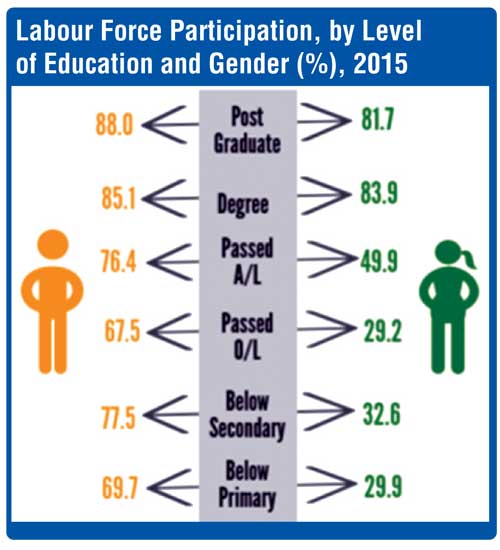Saturday Nov 29, 2025
Saturday Nov 29, 2025
Tuesday, 17 October 2017 00:00 - - {{hitsCtrl.values.hits}}
The Economic Statement of October 2016 presented by the Prime Minister envisages increasing the growth rate of the Sri Lankan economy to 7%, with the objective of doubling per capita incomes by 2025.
Given that the Sri Lankan economy is closely integrated with the rest of the world, achieving a sustained average growth rate of 7% will only be possible if the country manages to stay competitive in the global market. With the graduation to low middle income status and rising wages, continuing to compete on cheap labour is no longer a viable option for Sri Lanka. Instead, the country will need to facilitate and improve market sophistication and efficiency to improve productivity and competitiveness of the economy.
Overall, Sri Lanka ranked 71 out of 138 countries in the Global Competitiveness Index (GCI) with a score of 4.2 in a 1 to 7 scale. Despite an overall ranking of 71, Sri Lanka’s rank according to the labour market efficiency pillar was only 128 out of 138 countries. This indicates that labour market inefficiencies are one key factor that is holding back competitiveness in the country. Furthermore, female labour force participation ranked at 126 out of 138. In this Chapter, the focus will be on two main constraints that are holding back labour market efficiency in Sri Lanka: a) stringent employment protection laws; and b) low female labour force participation rates.
Improving labour
market efficiency 
Many developing countries still rely on job protection to ensure income security and severance pay systems to provide compensation for workers during layoffs. In addition to being inefficient, high level of job protection coupled with severance pay is not very effective as a means of providing income support during unemployment spells.
Studying the severance pay systems in several countries around the world, some studies propose two options for developing countries as an alternative for severance pay and unemployment insurance schemes. First, following the Australian severance pay reforms of 2003, converting severance pay to a pre-funded individual account has been proposed. Under this scheme, firms make regular payments (1.5377% of payroll) to individual accounts of workers specifically setup for use by the workers during unemployment spells.
The second proposal follows the Chilean unemployment insurance reforms of 2002. Here, it has been proposed to convert the severance pay system into a hybrid system which couples individual savings accounts with pooled savings accounts for use for income security during unemployment spells. Under the Chilean scheme, workers and firms contribute 3% of wages towards two unemployment insurance funds, an individual savings account and a pooled savings account.
Improving female labour force participation
Evidence shows that low labour force participation is more an issue for low skilled females. The FLFP increases steadily with education for those with at least O-Levels. In fact, the labour force participation rates of females with degrees are on par with that of males with degrees.
Like for many other countries, the majority of household responsibilities and child care activities are the responsibility of females in Sri Lanka. This is the case in spite of the economic participation of females. Spending around six hours a day on cooking, cleaning and child care activities leaves females little time for market work. It is not surprising that females look for more flexible work opportunities.
Also, such large time constraints prevent females from engaging in training activities which could improve productivity or in seeking career progression which could impair their home production activities. Given the more severe time constraints faced by females, they also tend to choose work opportunities closer to their residences.
Policy recommendations
On the effect of high redundancy costs, the analysis finds that the present severance pay system operational in the country is instrumental in reducing the flexibility of the labour market. Sri Lankan policy makers have already recognised the need for reforming the severance pay system in the country. But, the reforms introduced in 2003 and 2005 have not achieved the desired objectives as even after the reforms, job protection available for workers is very high, reducing the flexibility of the labour market and growth of permanent formal sector jobs.
Sri Lanka should learn from the best practices in reforming the severance pay system to introduce more flexibility to the labour market, while ensuring income protection of workers. Further, as shown in the analysis, such schemes can be designed to reduce the vulnerability of non-permanent workers and give them greater security in the market.
The evidence suggests that education is instrumental in improving the labour force participation of females, with higher levels of education as well as vocational training helping to improve economic participation of females. Improving education opportunities for females can increase their productivity both at home and in the work place.
Lessons learned from other countries show that to successfully improve labour force participation of females, economic policies aimed at facilitating work place flexibility, job creation and improving working conditions need to be implemented hand-in-hand with policies for lessening the burden of home production activities for women, through better quality affordable child care, better transport facilities and better access to time saving technologies.
[This Policy Insight is based on the comprehensive chapter on Labour Market Reforms for Growth in the ‘Sri Lanka: State of the Economy 2017’ report – the flagship publication of the Institute of Policy Studies of Sri Lanka (IPS). The complete report can be purchased from the publications section of the IPS, located at 100/20, Independence Avenue, Colombo 7. For more information, contact the Publications Unit on 0112143107/0112143100.]